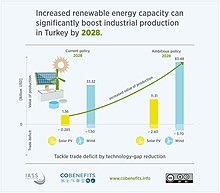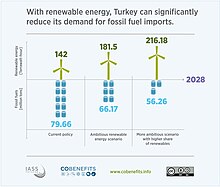Renewable energy in Turkey

Although there are plenty of renewable resources for energy in Turkey,[1] only hydropower has been much developed, averaging about a fifth of national electricity supply.[2] However, because this is vulnerable to droughts, less electricity than usual is from hydro in those recent years,[3] compared to around a third in a wet year.[4] The country is aiming for two thirds of electricity to be from renewables by 2023[5] but Turkey has invested less in solar and wind power than similar Mediterranean countries.[3] Turkey needs a renewable energy plan beyond 2023 which includes transport, industry, heating and cooling as well as electricity generation.[2] Turkey is a net exporter of wind power equipment but a net importer of solar power equipment.[6]
Hydroelectricity in Turkey is the largest renewable source of electricity and in 2018 generated 20% of electricity with other renewables at 12%.[7]
Geothermal power in Turkey is used mainly for heating. By massively increasing production of Turkey's solar power in the south and Turkey's wind power in the west the country's entire energy demand could be met from renewable sources.[8] A green tariff is planned for June 2021.[9]
Solar energy[]

| Year | 2015 | 2017 | 2019 | 2023 |
|---|---|---|---|---|
| MW | 300 | 1,800 | 3,000 | 5,000 |
Solar energy potential in Turkey is 977,000 (TWh/year) from which 6105 (TWh/year) is technically possible. According to modelling[11] by Carbon Tracker new solar power became cheaper than new coal power in 2020, and will become cheaper than existing coal plants in 2023.[12]
Wind power[]

This section needs to be updated. (February 2019) |
Wind energy technical potential is 290 TWh/year. According to another industry source the total installed power reached 5.789 GW by year end 2016 and the percentage of electricity consumption provided by wind power grew from under 1%, in 2009 to 5.59% by 2016 and is forecast to reach 12% of electricity consumption with the completion of planned facilities.[13] According to modelling[14] by Carbon Tracker new wind power became cheaper than new coal power in 2020, and will become cheaper than existing coal plants in 2027.[15]
Bioenergy[]
Biomass is also a major renewable energy resource in Turkey as the biomass economical potential of Turkey is 8.6 mtoe/year.[1]
Hydroelectricity[]


This section needs to be updated. (February 2019) |
Many dams have been built throughout the country, and about 23GW of power can be generated by hydroelectric plants.[16] There are many projects currently in progress, such as the Southeastern Anatolia Project, which will allow generation of 15GW through hydroelectric energy.[17] Technical potential of hydraulic energy is 216 TWh/year and economical potential is 127.4 TWh/year.[1]



60,000 people are employed as of 2020 and it is estimated employment could be boosted to 80,000 if rooftop solar is boosted.[18]
Geothermal power in Turkey[]
This section needs expansion with: research on CO2 emissions. You can help by . (February 2019) |
Turkey is ranked seventh richest country in the world in geothermal potential.[19] Turkey reaches milestone 1,100 MW of installed geothermal power generation capacity in December 2017. Turkey is fourth largest in the world in 2018 when it comes to installed capacity after United States.
Storage and integration[]
There is a virtual power plant which includes geothermal, wind, solar and hydro.[20] Increasing Turkey's proportion of electric cars in use to 10% by 2030 would help integrate variable electricity.[21]
Feed-in-tariffs[]
As of March 2021 for projects starting generating in July feed-in-tariffs in lira per kWh are: wind and solar 0.32, hydro 0.4, geothermal 0.54, and various rates for different types of biomass: for all these there is also a bonus of 0.08 per kWh if local components are used.[22] Tariffs will apply for 10 years and the local bonus for 5 years.[22]
Employment, industrial production, and balance of trade[]
This section needs expansion. You can help by . (March 2021) |
There are benefits in all these areas.[23]
Health benefits[]

Possible health benefits of expanding renewable energy more quickly have been estimated at USD 800 million a year.[23]
See also[]
- List of renewable energy topics by country
- Energy conservation#Turkey
References[]
- ^ Jump up to: a b c DAWOOD, KAMRAN (2016). "Hybrid wind-solar reliable solution for Turkey to meet electric demand". Balkan Journal of Electrical and Computer Engineering. 4 (2): 62–66. doi:10.17694/bajece.06954.
- ^ Jump up to: a b "Lessons from global experiences for accelerating energy transition in Turkey through solar and wind power" (PDF). Shura. Retrieved 19 February 2019.
- ^ Jump up to: a b Saygılı, Hülya. "RENEWABLE ENERGY USE IN TURKEY". CBRT blog. Retrieved 17 February 2019.
- ^ "Turkish authorities aim to boost renewable power generation to 50 percent by 2023". Daily Sabah. 2018-08-24.
- ^ "Turkey looks to raise share of renewables to two-thirds by 2023". Daily Sabah. 2019-06-17.
- ^ "How Turkey Can Ensure a Successful Energy Transition". Center for American Progress. Retrieved 19 February 2019.
- ^ "Electricity". Ministry of Energy and Natural Resources (Turkey). Retrieved 16 November 2020.
- ^ Kilickaplan, Anil; Bogdanov, Dmitrii; Peker, Onur; Caldera, Upeksha; Aghahosseini, Arman; Breyer, Christian (2017-12-01). "An energy transition pathway for Turkey to achieve 100% renewable energy powered electricity, desalination and non-energetic industrial gas demand sectors by 2050". Solar Energy. 158: 218–235. Bibcode:2017SoEn..158..218K. doi:10.1016/j.solener.2017.09.030. ISSN 0038-092X.
- ^ "Elektri̇k Pi̇yasasinda Yeni̇lenebi̇li̇r Enerji̇ Kaynak Garanti̇ Belgesi̇ Yönetmeli̇ği̇". www.resmigazete.gov.tr. Retrieved 2021-01-02.
- ^ "PVPS Annual Report 2015, p109".
- ^ "GLOBAL COAL POWER ECONOMICS MODEL METHODOLOGY" (PDF).
- ^ "WIND VS COAL POWER IN TURKEY/SOLAR PV VS COAL IN TURKEY" (PDF). Carbon Tracker. 2020.
- ^ "Rüzgar Enerji Santralleri". Enerji Atlası (in Turkish). Retrieved 2017-12-01.
- ^ "GLOBAL COAL POWER ECONOMICS MODEL METHODOLOGY" (PDF).
- ^ "WIND VS COAL POWER IN TURKEY/SOLAR PV VS COAL IN TURKEY" (PDF). Carbon Tracker. 2020.
- ^ "Turkey country profile". International Hydropower Association. Retrieved 2 March 2015.
- ^ "Reaching for Turkey's Hydropower Summit". Hydroworld. Retrieved 2 March 2015.
- ^ Agency, Anadolu (2020-03-11). "Solar rooftops expect to see 66% rise by year-end". Daily Sabah. Retrieved 2020-03-23.
- ^ DAWOOD, KAMRAN (2016). "Hybrid wind-solar reliable solution for Turkey to meet electric demand". Balkan Journal of Electrical and Computer Engineering. 4 (2): 62–66. doi:10.17694/bajece.06954.
- ^ "First integration of geothermal power assets into virtual power plant in Turkey". Think GeoEnergy - Geothermal Energy News. Retrieved 2020-09-07.
- ^ "Transport sector transformation: Integrating electric vehicles into Turkey's distribution grids" (PDF).
- ^ Jump up to: a b Olğun, Kinstellar-Şeyma. "New Turkish-Lira tariff scheme for renewable energy projects in Turkey | Lexology". www.lexology.com. Retrieved 2021-02-03.
- ^ Jump up to: a b "COBENEFITS". Retrieved 2021-03-31.
Sources[]
- 2019-2023 Strateji̇k Planı [2019–2023 Strategic Plan] (Report) (in Turkish). Ministry of Energy and Natural Resources (Turkey). May 2020.
- Cobenefits Policy Report: Unlocking the co-benefits of decarbonising Turkey’s power sector (Report). IASS IPC/UfU. December 2020.
External links[]
![]() Media related to Renewable energy in Turkey at Wikimedia Commons
Media related to Renewable energy in Turkey at Wikimedia Commons
- Renewable energy in Turkey
